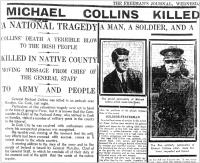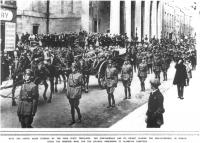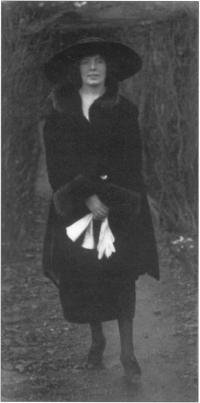Michael Collins and the media–then and now
Published in 20th-century / Contemporary History, Features, Issue 3 (Autumn 1995), Revolutionary Period 1912-23, Volume 3Just over seventy years ago in the early evening of 22 August 1922 a car stopped at Newcestown church County Cork and its principal passenger wandered alone in the churchyard. Then driver and passenger set off north-eastwards and turned left at Quarry Cross to take the road to Bealnablath and then on to Cork. The car was accompanied by a light armoured car and an armed escort riding in a Crossley tender but, despite this the passenger never arrived. As his convoy began the slight descent towards the gorge that gives its name to the village of Bealnablath, shots rang out from the scrubby trees lining the boreen to the west and Lieutenant Smith riding point on his motor cycle saw a cart blocking the road, swerved, and fell off, rolling into the ditch for cover.
General Michael Collins, Major-General Emmett Dalton and the accompanying soldiers took cover behind the vehicles and returned fire. As the shadows lengthened the attackers began to disengage. Collins sensing this stood to take better aim with his rifle, a shot rang out and he fell mortally wounded. The attackers moved away, the soldiers gently carried their commander to his car and the convoy slowly made its way to Cork city. The most powerful man in Ireland had been killed almost accidentally by a ricochet a matter of some twenty miles from his birthplace. He was not yet thirty-two years old.
Collins’ posthumous reputation still defies consensus as any perusal of his biographies will reveal and the uneasy anticipation with which Neil Jordan’s film of his life has been awaited. The press in Britain and Ireland carried long reports and appreciations over the days which followed. Although writing for readerships whose perceptions of events in Ireland were very different there is a remarkable degree of agreement about Collins’ place in history in the various British and Irish papers in August 1922. Most of the principal Irish papers were pro-government and this was reflected in the column inches devoted to Collins’ death.
 Freeman’s Journal
Freeman’s Journal
The Freeman’s Journal talked of a ‘calamitous tragedy’ on the 23rd and on the 24th of ‘stunned despair throughout the land’ and archly hinted that the republicans, ‘these Irishmen’, were ‘puppets of politicians who are not Irish’, laying the blame for the situation at de Valera’s and Erskine Childers’ door. Under the headline ‘Life story of the soldier chief’ the Journal set about establishing the posthumous myth of the freedom fighter who, with a price on his head had risked his life for Ireland. This included an emotionally worded listing of his personal qualities of bravery, generosity, military prowess, and readers were reminded of his skill as an orator. The fatal ambush was suitably exaggerated. According to the Journal, Collins’ convoy was ambushed by some 200 attackers (in fact there were about a dozen of them), large numbers of the ‘irregulars’ were killed and his final words were ‘forgive them’. The elements of this exaggerated report of the action at Bealnablath found their way into many papers on both sides of the Irish sea.
Irish Independent
The Irish Independent of the 23rd reported the shooting and gave a cooler account of Collins’ life. He was described as ‘the ablest and most dangerous adversary of the British forces operating in this country’ during the Anglo-Irish war, ‘a key member’ of the Treaty negotiation team and his performance in the Dáil as ‘statesmanlike and convincing’. The edition of the 24th carried alleged details of ‘thrilling incidents in an eventful life’ and likened Collins to ‘Danton—possessing the qualities of the soldier, the tribune and the revolutionary’. The Independent gave three reasons for Collins’ signature of the Treaty, his know}edge of the actual condition of the IRA, an appreciation of the danger of splitting the negotiating team and a capacity for ‘the long view’.

The funeral of Michael Collins
(illustrated London News Picture Library)
Irish Times
The Irish Times reported his death on the 23rd and printed a short but sympathetic biography which described his ability to evade capture during the Anglo-Irish war as ‘something akin to witchcraft’. Editorial comment saw Collins as ‘standing for stable government and the restoration of civilised conditions to our distracted country’. ‘His death is a disaster for Ireland’, it continued and stated that ‘his courage and sincerity rallied round him all the best and sanest elements in Irish life’. The unionist Irish Times had its colours nailed firmly to the mast perceiving that the Free State government was, if not the best, then certainly the least bad option of the day. The tone was maintained the following day with the clearly expressed realisation that no full appreciation of the effects of Collins’ death on Irish politics was yet possible. He was seen as a victim of the ‘malignant fate which seems to dog the footsteps of Irish history’. Interestingly, the Irish Times praised Collins’ attempts to achieve Irish unity and the pact with Craig was seen as ‘a flash of genius’.
Belfast Telegraph
Not unexpectedly the Belfast Telegraph reflected a different view of Collins. ‘It is not for us to judge the man, he has gone to his last account, and we are willing to believe that he sincerely intended to carry out the Treaty and to restore order in Southern Ireland’ (sic). The uncompromising tone continued, ‘…he has fallen by the means so frequently adopted, prior to the Treaty, of killing policemen and soldiers. A large section of the Irish regarded those ambushes against Crown forces as part of a war, therefore excusable. They were hopelessly wrong from every point of view and today they will perhaps realise it when they recall that the Commander-in-Chief of their own army has been slain by exactly the same method’. The Telegraph thundered on concluding with an oblique criticism of the British government, expressing the hope that Collins’ death would ‘make his countrymen the more determined to make a success of the scheme which British statesmen, rightly or wrongly, have committed to their charge’. A further article gave an unexceptional biographical account but lapsed into sectarian hyperbole when recounting how Collins allegedly evaded capture on one occasion by taking the place of the dear-departed at a wake. ‘Tobacco smoke and whiskey fumes’ provided suitable couleur locale to enhance the disapproval of its Protestant readership.

Kitty Kiernan – the modern press in Ireland has attempted to fill out Collins’ relationships with women in a sensational manner.(Hulon Deutsch)
Cork Examiner
The Cork Examiner carried no report of Collins’ death on the 23rd due to the delays caused by censorship and the peculiar circumstances in Cork at the time. Dalton’s control of the city was not yet totally secure. But on the 24th a fulsome tribute to Collins was published which echoed the sentiments in other papers but added the feeling that the civil war would now become more bitter with long-lasting consequences.
Poblacht na hÉireann
What of his opponents? Poblacht na hÉireann—War News No. 47 of 24 August, the news sheet of the anti-Treaty forces, published a piece by Erskine Childers who, it was reported, was deeply moved by the shooting. He wrote, ‘He has given his life for the Treaty and, not less readily than the closest of his brother officers, we acknowledge his bravery’. Childers concluded by blaming the whole sorry business on the treachery of the English ministers who tricked the Irish into becoming part of their ‘diabolical Empire’. One must appreciate the ambivalent feelings of so many that would read it, and the emotions of Childers himself who carried a tiny pistol presented to him by Collins himself.
The British press
Across the Irish sea emotion had no place in newspaper reports of the death of Michael Collins. The Times under an unintentionally ironic headline, ‘Rebels still active’ reported his death on the 23rd. A fuller report followed on the next day commenting that ‘once he had given his word—even to his former opponents—he turned strenuously to the task of making it good’. The combination of Griffith and Collins at the head of the Irish government was acknowledged as having been formidable. The paper felt that in the trials that faced the new Ireland ‘Collins would have talked with the enemy at the gate’. His death was seen as ‘a heavy loss for Ireland’ since ‘he was truly a strange though hopeful portent of his time’. J.L. Garvin in the Observer on 27 August took a high moral tone showing little interest in Collins the man but echoing the outlook of the Belfast Telegraph. Now that Collins was gone, he saw that the civil war would shortly be carried on with ‘a new stringency…implacably determined’ which was the only possible response to a conflict that had ‘no longer purpose or hope’.
The Manchester Guardian on 24 August gave a fanciful description of the scene of the ambush in country ‘as wild as any part of the West of Ireland, a place of hills, boulders and bogs’. The account of the ambush was equally fanciful echoing the exaggerations of the Freeman’s Journal. Yet there was an accurate assessment of Collins’ attempts to bring the war to a speedy conclusion without increasing ‘the rancour of those with whom he had formerly been comrade’. His death was seen as heralding ‘a period of reprisal and counter reprisal’. The Daily Herald saw his death as ‘the tragedy of waste’ and provided its readers with a potted biography headed ‘Romantic Life Story—Career filled with stirring adventure’ which aptly set the tone for what follows and which curiously included the apocryphal story of the escape at the wake.
It is well to remember that newspapers were the media in 1922. Radio was in its infancy in Britain and unknown in Ireland. Film newsreels were the papers’ only competition and the portable technology and sharp techniques of video reporting that we are so used to today were some five decades into the future.
Sensational speculation
The principal difference between modern papers and those of 1922 is that no attempt was made to comment on Collins’ attachment to Kitty Kiernan of Granard. The modern press in Ireland has attempted to fill out his reputation by exploring his relationships with women in a sensational manner. But modern journalists forget that Michael Collins was a child of his time. He was a turn-of-the-century Catholic country boy, used to the company of women, used to working with them and to relying on women friends as confidantes. No biographer suggests as do some modern journalists that he was a sexual adventurer. That he was attractive to women is not in dispute but these suggestions are a modern manifestation of his opponents’ theory that he was corrupted by his time in London while negotiating the Treaty with Lloyd-George. A four-page supplement on Collins in the Irish Press on 12 October 1990, for example, devoted some twenty-five per cent of its space to this sort of speculation. What might have been the ultimate fate of his relationship with Kitty is impossible to say but that she was very much in love with loving him is beyond doubt.
In Ireland the reporting of Collins’ death showed a wide variety of response according to the political tendency of the respective papers. At one level there were genuine attempts to provide an assessment of the man, his qualities and of his contribution to independent Ireland. At another there was the attempt at the construction of a myth which could be used to consolidate the legitimacy of the Free State in the popular mind. Collins the patriot, administrator, minister and soldier had facilitated the birth of the Free State and therefore that state was the embodiment of Ireland free. Consequently to oppose the government of the state was to oppose Ireland’s hard-won freedom. Here we see the hand of Piaras Beasalaí, government information officer and Director of Censorship. That the British press by and large should also use his material was an unexpected bonus.
Extremes of adulation counterproductive
However, this success was not durable. The extremes of adulation, particularly in the Freeman’s Journal, were to be counterproductive in later years. As Frank O’Connor put it in his 1937 book, The Big Fellow, ‘anecdote preserves the living man, but it exaggerates him’. There were certainly those in positions of influence if not direct power in Dublin during subsequent decades who reacted against this very exaggeration. Where the Freeman’s Journal had explicitly placed Collins with such as Parnell and O’Connell this view was not upheld in later years. What is surprising is the degree to which the memory of Michael Collins disappeared from the scene. Tim Pat Coogan blames de Valera for this, first for living so long and secondly for being haunted by Collins who was all that he was not. Reading the press of the time and allowing for hyperbole there is no doubt that Collins was the man of his time.
This is the problem. Ireland after 1923 was a very different place to the Ireland that he had known and worked for. Independence had arrived and the bill had to be paid in a certain sense. The civil war left deep scars and these took a generation to form new tissue if not to heal completely. Reconstruction and economic development was slow, the relationship with Britain difficult and an international role not easy to find in the troubled Europe of the following forty years. The six counties in the north were ignored, just as they were by Britain, until the events of 1969 reminded everyone that they were still there. In short, not just the goal posts, but the entire stadium moved. What remains appropriate is not to forget what was written about him in the newspapers of 1922
To suggest what he would have done had he lived is fascinating but does not lead far. The early years of the Free State would have been very different. Faced with the same problems as Cosgrave in 1923 he would have responded more vigorously and would have handled his public relations much more effectively. One can imagine, for example, the effect of a Collins tour of America. The newspapers of August 1922, particularly in Britain, were groping towards a realisation of this. Their preoccupation with what was going to happen next was not just a concern with the possible developments in the civil war in Ireland but a realisation that a tragic vacuum had been created with Collins’ removal from the scene. They had no means of knowing that an iron parliamentarian like O’Higgins was to emerge behind Cosgrave and, like everyone else, not the least idea what de Valera would do. Both the 1922 newspapers and the biographies tread lightly on Collins’ ideas of uniting Ireland. Talbot in his 1932 biography reviews Collins’ economic plans and repeats his notion of a thirty-two-county Ireland as an economic unit but fails to take the matter further. Yet there remains the distinct feeling that Collins’ approach to the Boundary Commission, partition and the establishment of an Irish Republic would have been far more robust.
Ian McKeane is a postgraduate history student at the Institute of Irish Studies, University of Liverpool.
Further reading:
T.P. Coogan, Michael Collins (London 1990).
L. O’Broin, In Great Haste (Dublin 1983).
C. Younger, Ireland’s Civil War (London 1970).
















